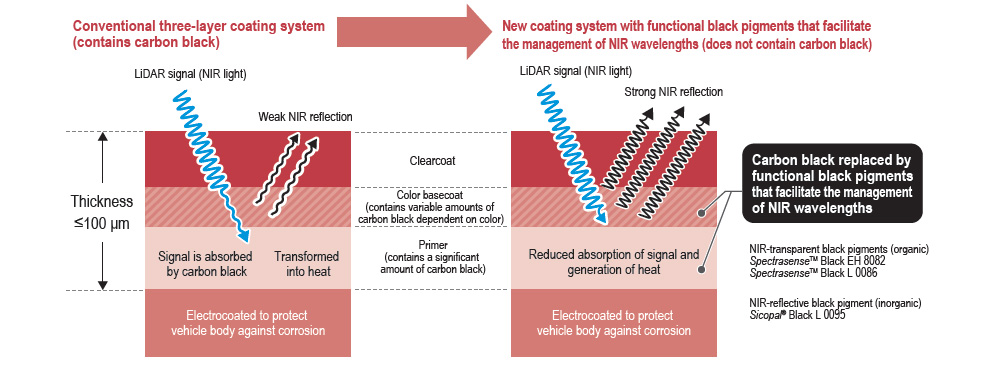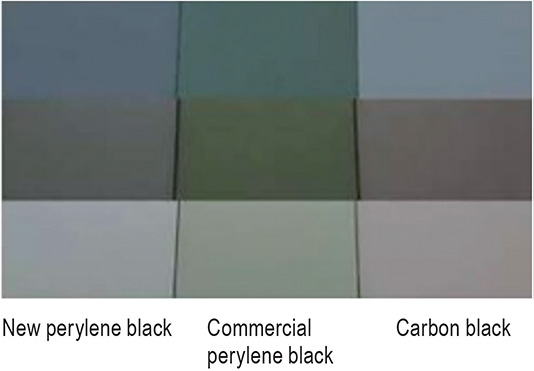Special Feature
Functional black pigments that combine outstanding LiDAR
signal response and visual appeal
Spectrasense™ Black EH 8082, Spectrasense™ Black L 0086
and Sicopal® Black L 0095

The DIC Group has pioneered key NIR-management solutions that will help automotive coating systems ensure safe, secure and richly colored vehicles.
Value Creation Leveraging functional pigments to assist autonomous driving and enhance visual appeal
The benefits and drawbacks of using carbon black in automotive coatings
Automakers the world over are focused on developing next-generation mobility
technologies for the smart society of the future that will facilitate autonomous driving,
which will make it possible for anyone and everyone to get around safely and securely.
Leading the charge is light detection and ranging (LiDAR), which detects the shape
and distance of surrounding objects by irradiating them with a near-infrared (NIR) laser
and measuring the light reflected back to the system’s detector, enabling autonomous
driving vehicles to “see” where they are going and preventing them from bumping
into or colliding with other vehicles or obstacles. However, conventional automotive
coatings contain carbon black, a material consisting of fine carbon particles, which
largely absorbs the NIR wavelengths of LiDAR signals and incident sunlight, causing
heat build-up and significant reduction of object detection capabilities.
The obvious question is that if LiDAR object detection capabilities are the priority,
why not just use something other than carbon black? Unfortunately, it’s not that
simple. In addition to providing excellent coverage, carbon black increases the
durability and conductivity of coatings, making its replacement with another material
difficult. Carbon black also plays an important role in body color, a key consideration for consumers’ decision making when purchasing a vehicle. Without using carbon
black, it is difficult to produce dark colors, including deep blacks, greens, blues and
reds, or neutral colors such as metallic grays. Accordingly, automakers have faced
a challenge in that the more they emphasize LiDAR signal response, the less color
design freedom they retain.

The NIR wavelengths of LiDAR signals are absorbed by the carbon black pigment of automotive coatings, significantly hindering signal response.
Developing a color formulation approach that produces clean, deep colors without hindering LiDAR detection
In March 2021, Colors & Effects, the pigments business of Germany’s BASF, one of the
world’s leading chemicals manufacturers, succeeded in developing a color formulation
approach that produces clean, deep colors without the use of LiDAR signal–absorbing
carbon black. (Colors & Effects was acquired by DIC in July 2021.)
The conventional automotive coating process involves three key layers: A primer, which
evens out surface irregularities and protects the electrocoat; a basecoat, which imparts the main color; and a clearcoat, which seals everything, providing shine and protection against
external elements. It is in the primer and the basecoat that carbon black, which absorbs
NIR wavelengths in LiDAR signals, is typically used. Similar pigmentation considerations
can be used if the paint system omits the conventional primer and instead uses a
combination of two modified basecoat layers to fulfill the combined roles of the primer and
the basecoat.
Colors & Effects sought to address the problem of carbon black as a pigment in coatings
for autonomous driving vehicles by embarking on the development of color formulations that
enable the management of NIR wavelengths in automotive coatings by using a primer and
a basecoat containing NIR-transparent and NIR-reflective functional black pigments that
selectively transmit and reflect back NIR wavelengths while ensuring the high performance
required for each coating layer. By using NIR functional pigments as replacement for
carbon black—NIR-transparent black pigments from the Spectrasense™ Black product
range (Spectrasense™ Black L 0086 and the new Spectrasense™ Black EH 8082) or an
NIR-reflective black pigment from the Sicopal® Black product range (Sicopal® Black L
0095)—formulations were created which allowed LiDAR signals to penetrate through and
reflect back, instead of being absorbed, while at the same time achieving the depth of color
needed for high-end vehicles.
This new color formulation approach makes it possible for manufacturers of coatings for
autonomous driving vehicles, which will be indispensable to the smart society of the future,
to break free from dependence on carbon black and deliver both outstanding sensing
performance and visual appeal. Because this approach is suitable not only for automobiles
but also for a variety of industrial products where sensors are used, potential applications
span multiple scenarios.


A Distinctively DIC Respon Realizing a revolutionary perylene black pigment that improves jetness and enhances neutral colors
An issue that cannot be resolved simply by reflecting NIR
The impetus behind Colors & Effects’ efforts to develop a new color formulation
approach was a project to develop LiDAR-based positional mapping technologies for
use in advanced driver assistance systems (ADAS). A major challenge for developers
was of course the presence of carbon black.
The fact that carbon black absorbs and stores NIR light is well known. Colors
& Effects had previously developed pigments that reduced the absorption of NIR
wavelengths—thus exerting a heat-shielding effect—for coatings used in building
materials for roofs and outer walls and enjoyed a significant share of the global
market for pigments used in coatings for energy-efficient building materials. However, simply applying existing technologies would not resolve all the issues for automotive
coatings. Automakers and coatings manufacturers alike demanded a coating system
that would ensure LiDAR object detection capabilities while at the same time enabling
the creation of dark colors with improved jetness, as well as metallic grays and other
neutral colors. To this end, it was necessary to develop a new functional black pigment
to replace carbon black that was also easy to incorporate into coating systems that
take LiDAR transmission, absorption and reflection into account, and was optimized
for the composition of automotive coatings.
Helping realize innovative coating systems through the optimal combination of pigments that facilitate the management of NIR wavelengths
Colors & Effects commenced full-scale development in 2018 by thoroughly analyzing and
evaluating the impact of carbon black on LiDAR signals, including examining the scattering,
absorption and reflection of NIR light and performing colorimetric assays. Narrowing its
focus to perylene black, an organic compound that possesses multiple hues, the company
developed Spectrasense™ Black EH 8082, an innovative perylene black pigment that
improves transmission of the NIR wavelengths in LiDAR signals and enhances jetness by
absorbing visible light better than other NIR management black pigments on the market. By
using this new neutral colored black pigment in combination with other NIR reflective or nonabsorbing
pigments, formulations were created for the primer and basecoat layers which not
only provided excellent LiDAR reflectivity but also allowed desirable colors from the whole
color palette to be formulated. Due to the neutral color and high jetness of SpectrasenseTM
Black EH 8082, for the first time neutral gray and black colors were achievable simply by use
of the black pigment in combination with other reduction pigments. No additional tinting or adjustment is needed unless a color shift is required to achieve the design color.
Completed in March 2021, the new, improved NIR-transparent black pigment,
Spectrasense™ Black EH 8082 immediately earned acclaim from both coatings
manufacturers and automakers, for the potential it offers in eliminating dependence on
carbon black pigments and opening the way to the realization of a smart society.
DIC’s decision to acquire the Colors & Effects business, a business partner of wholly
owned U.S. subsidiary Sun Chemical Corporation, was prompted by the German company’s
advanced pigment development technologies and experience as a key supplier to all the
leading global automotive coatings manufacturers, both of which it believes are essential to
the realization of the targets it has set, which are outlined under its DIC Vision 2030 longterm
management plan. As
this new color formulation approach shows, the acquisition has already proved highly fruitful.
Message
The reaction from automakers and the coatings industry has been tremendous!
Development of a quantitative measuring method through modification of a UV/Vis/NIR spectrophotometer
Colors & Effects had experience dealing with heat-management applications through the development of pigments with heatshielding
functions. Nonetheless, undertaking a project to develop pigments for automotive coatings compatible with autonomous
driving systems that would both enhance LiDAR signal responsiveness and improve dark and neutral colors was a major challenge.
In the initial phase of this project, the focus was to understand how LiDAR signals behaved at various angles of incidence
when encountering a coating stack comprising three layers formulated with functional pigments. The tools needed to make such
measurements were not readily available for experiments under reproducible lab conditions, so assistance was sought from a
leading equipment manufacturer. With this company’s help, modifications were made to a commercial ultraviolet–visible/NIR (UV/
Vis/NIR) spectrophotometer, enabling measurements to be made across a 300–2,500 nm wavelength range while varying the
incidence angle of the measured sample. This allowed comparative measurements of coated objects, to determine the degree to
which carbon black negatively affects LiDAR signal response at different incidence angles and how much this improves with NIRtransparent
black pigments, the outcome of which played a key role in subsequent pigment development efforts.

Global Innovation Manager–
Organic Pigments,
Color Materials,
Sun Chemical Corporation
Dr. Paul Brown
The difficulty of producing neutral metallic grays
One of the most difficult tasks when using alternative pigments—including existing commercial
NIR-transparent black pigments from the Spectrasense™ Black range—as replacement for
carbon black was to facilitate the production of neutral metallic grays. When combining existing
Spectrasense™ Black products with neutral pigments such as titanium dioxide, silver mica and
aluminum, the color shifts into the green or reddish-blue color space, requiring the addition of
other color pigments to counter the undesired undertone.
To overcome this issue, information available in related literature was combined with internal
expertise to develop a method for controlling the crystal structure of the perylene, thereby
controlling the pigment color. This enabled the development of a new perylene black that
produces neutral colors in pigment reductions and fulfills the NIR transparency requirements
for LiDAR-detectable color formulations at all viewing angles. Importantly, the approach was
effective not only in the laboratory but also when scaled up to commercial production level. This
breakthrough makes it possible to achieve NIR-reflective neutral metallic grays (solid and effect
shades) without the need for color correction with another pigments.
LiDAR Signal Response: Carbon Black vs. Functional Black Pigments

Commercialization and production during a global pandemic
Technological development had progressed considerably before COVID-19 spread to Europe and by the time it was declared a pandemic, development was
already at the stage where advanced prototypes were being sampled to major customers with whom active nondisclosure agreements were in place. Given the
global situation, however, significant challenges remained in finding an effective way to obtain detailed feedback on the testing of the prototypes so that any final
adjustments could be made to the pigment prior to commercialization in 2021.
Under normal circumstances, face-to-face meetings with customers, and with pertinent in-house groups, would have taken place. However, given the pandemic
all communications had to be conducted via online meetings. In general, limited experience existed in conducting in-depth discussions remotely, but despite
some initial frustrations, effective communication was achieved, resulting in successful completion of the project and the subsequent launch in the market in
2021. Everyone involved in the development, commercialization and production of the new pigment, as well as our customers, deserves a big thank you.
Earning the best presentation award at the FOCUS conference
The Detroit Society of Coatings Technology (DSCT) holds an annual Future of Coatings Under Study (FOCUS) conference for the discussion of notable themes
and urgent issues. This event is attended by original and contracted coatings manufacturers from around the world, as well as by leading global automakers.
More than 250 people took part in the May 2021 conference, which was held remotely to curb the spread of COVID-19. During the conference, Colors & Effects
gave a presentation on the reflectivity of coatings and LiDAR detection during which it detailed its success in realizing a method for measuring variable angle
intensities of reflected LiDAR radiation and developing a new perylene black pigment with neutral coloristics. The messages delivered in the presentation were
well received by the organizing committee and Colors & Effects was pleased to receive the best presentation award.
The extremely positive response to our FOCUS presentation confirms that Colors & Effects’ pigments technologies are seen as leaders in the area of pigments
for LiDAR-detectable colors. Further R&D will continue in this area with the aim of contributing to increased design freedom.
KEY PERSON of DIC
This new pigment yields a true black and offers great potential.

When the development personnel first showed me a panel coated with the prototype pigment, I was really excited and recognized that it had the
potential to become a massively important new product. We have introduced perylene black to manufacturers of automobile coatings many times in
the past, but have not been able to break into the area of color creation for automobiles, which requires the production of clean, deep colors with a
coating thickness of only 15 μm. The reaction from customers has always been the same: “It looks black, but it’s not a true black.”
We have received many favorable and encouraging comments in response to samples of Spectrasense™ Black EH 8082, and the physical
characteristics of coatings containing the new pigment have also earned positive reviews. Recently, stricter energy efficiency standards for
automobiles have prompted demand for pigments with heat-management capabilities, underscoring our belief in our ability to grow this new
business without waiting for the full-scale arrival of autonomous driving. This is a new functional pigment that enables the creation of a true black
coating, and I can feel confident in recommending for a wide range of applications.
Manager, Pigment Global Operation Strategy Planning Group, Color Material Products Division, Osaka Branch, DIC Corporation Shintaro Gomyo
The potential for pigments that can replace carbon black is unlimited.

To improve the safety of autonomous driving vehicles, it is essential to ensure that vehicles are able to detect things around them that they could possibly run into, from the clothes worn by pedestrians to bicycles, walls and construction cones. Many such objects feature colorants containing carbon black. In all of these cases, we need to replace carbon black with functional pigments that do not interfere with an autonomous driving vehicles’ ability to detect LiDAR signals. The potential applications for Colors & Effects’ functional black pigments really are innumerable. Moreover, carbon black absorbs NIR light in incident sunlight, causing heat build-up, so we also expect heat-management applications for these pigments to expand further.
Technical Industry Manager–Automotive, Sun Chemical Corporation Andre Bendo
This is another great example of how we advance technical and scientific expertise.

The influence of color pigments on coatings is not restricted solely to the visual regime. Despite the name, they also impact properties apart from color, defined in regions hidden to the human eye. One of these regions is NIR, which is relevant to both solar heat management and LiDAR. Control over the advanced properties of pigments is a key characteristic underscoring our position as one of the largest pigment producers and a global leader at the forefront of technological understanding and research. Our expertise led to the recent development of an outstanding functional black pigment, offering a multitude of possible usages by enabling targeted tuning of the NIR behavior of coatings. The new Spectrasense™ Black EH 8082 pigment is a clear demonstration of our deep knowledge of pigment chemistry and physics, as well as our highly skilled engineering capabilities.
Team Leader, Colorimetry & Pigment Physics, Color Materials, Sun Chemical Corporation Dr. Max Mussotter
Bringing together the know-how, technologies and sales channels of three companies is key to expanding sales of sustainable products.

With Colors & Effects, the operations of which focus on Europe, becoming a member of the DIC Group, we have implemented a threepronged
global color materials business management framework comprising this company, U.S. subsidiary Sun Chemical and DIC, which
oversees Group operation in Asia.
The new functional black pigments featured herein represent a pioneering sensing-related application for pigments that have long been
sold for use in heat-management applications. These sustainable products are evidence of Colors & Effects’ advanced technologies
and marketing capabilities. Looking ahead, we will work not only to expand sales of Colors & Effects’ functional color materials through
our global sales channels, but also to expand our product portfolio of products that contribute to sustainability by leveraging DIC’s R&D
capabilities to further enhance added value.
Manager, Color & Display Business Planning Department, DIC Corporation Mineo Yoda
Special topics 2022

Functional black pigments that combine outstanding LiDAR
signal response and visual appeal
Spectrasense™ Black EH 8082, Spectrasense™ Black L 0086
and Sicopal® Black L 0095
The DIC Group has pioneered key NIR-management solutions that will help automotive coating systems ensure safe, secure and richly colored vehicles.



World’s fastest-curing carbon fiber–reinforced prepreg
DICARBO® LF series
The DIC Group has developed a revolutionary method for producing CFRP—essential to lowering the weight and increasing the durability of vehicles—that significantly reduces CO₂ emissions and energy consumption attributable to production.





